
|
Agathocles may have been Pantaleon's brother, as both ruled at around the same time. Agathocles is dated to c. 185-170 BCE. We are not sure which of the
two ruled first, but I have elected to present the coins of Agathocles second because he issued a coin commemorating Pantaleon, indicating he came "after" Pantaleon
in some sense.
Agathocles produced some of the most
interesting coins of the Bactrian series, both because of their artsitry and their content. Notably, he issued a series of "Pedigree" coins honoring his predecessors on the
Bactrian throne, starting with Alexander the Great himself. Most of that series can be seen below. We do not know of coins commemorating Euthydemos II.
The one known coin type missing from the series below is a type honoring Diodotos and carrying the legend ΘEOY.
|
 |
Agathocles |
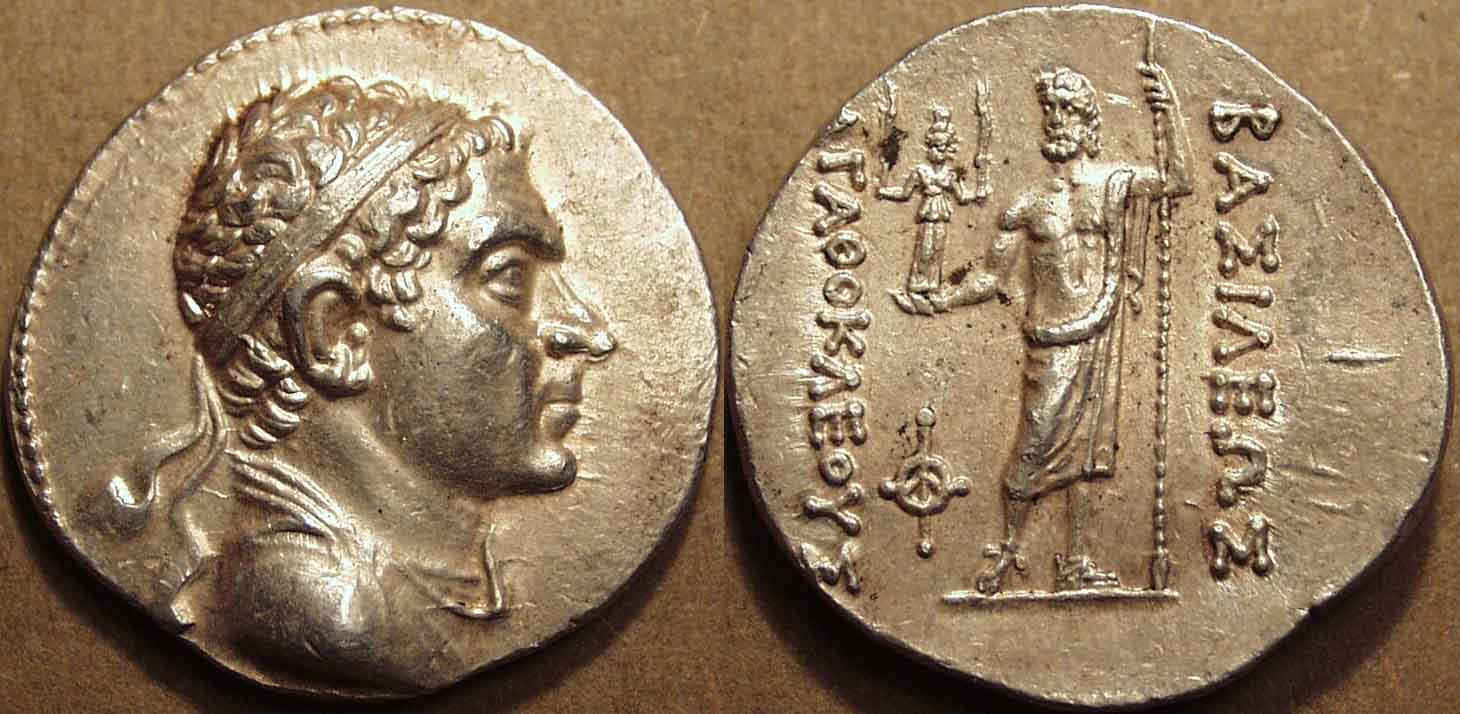
|
Bactria: Agathocles, Silver tetradrachm, c. 185-170 BCE
Weight: 16.90 gm., Diam: 30 mm., Die axis: 12 h
Diademed head of king facing right, pearled border around /
Zeus standing facing, holding sceptre with his left hand
and holding Hecate bearing flaming torches in his right hand,
Greek legend: BAΣIΛEΩΣ AΓAΘOKΛEOYΣ
monogram in lower left field |
 |
One of the great masterpieces of portaiture in the entire Hellenistic series. Note how Agathocles, just like Pantaleon, features
Zeus holding Hecate on the reverse, although standing rather than seated.
|

|
Bactria: Agathocles, Silver tetradrachm, c. 185-170 BCE
Weight: 16.73 gm., Diam: 33 mm., Die axis: 12 h
Diademed head of king facing right, pearled border around /
Zeus standing facing, holding sceptre with his left hand
and holding Hecate bearing flaming torches in his right hand,
Greek legend: BAΣIΛEΩΣ AΓAΘOKΛEOYΣ
monogram in lower left field |
 |
This example has an unusual, and very beautiful, style. For some reason, many Agathocles tetradrachms have a die flaw that
results in the king's face having a broken nose, but this and the previous coin have escaped that fate.
|

|
Bactria: Agathocles, Silver drachm, c. 185-170 BCE
Weight: 4.15 gm., Diam: 18 mm., Die axis: 12 h
Diademed head of king facing right /
Zeus standing facing, holding sceptre with his left hand
and holding Hecate bearing flaming torches in his right hand,
Greek legend: BAΣIΛEΩΣ AΓAΘOKΛEOYΣ
monogram in lower left field |
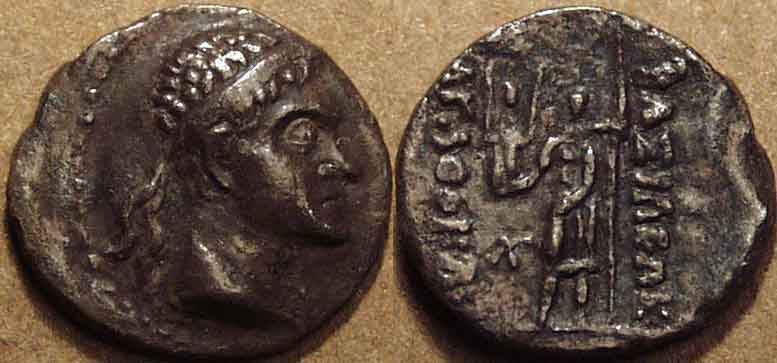
|
Bactria: Agathocles, Silver hemidrachm, c. 185-170 BCE
Weight: 1.69 gm., Diam: 14-15 mm., Die axis: 12 h
Diademed head of king facing right /
Zeus standing facing, holding sceptre with his left hand
and holding Hecate bearing flaming torches in his right hand,
Greek legend: BAΣIΛEΩΣ AΓAΘOKΛEOYΣ
monogram in lower left field |
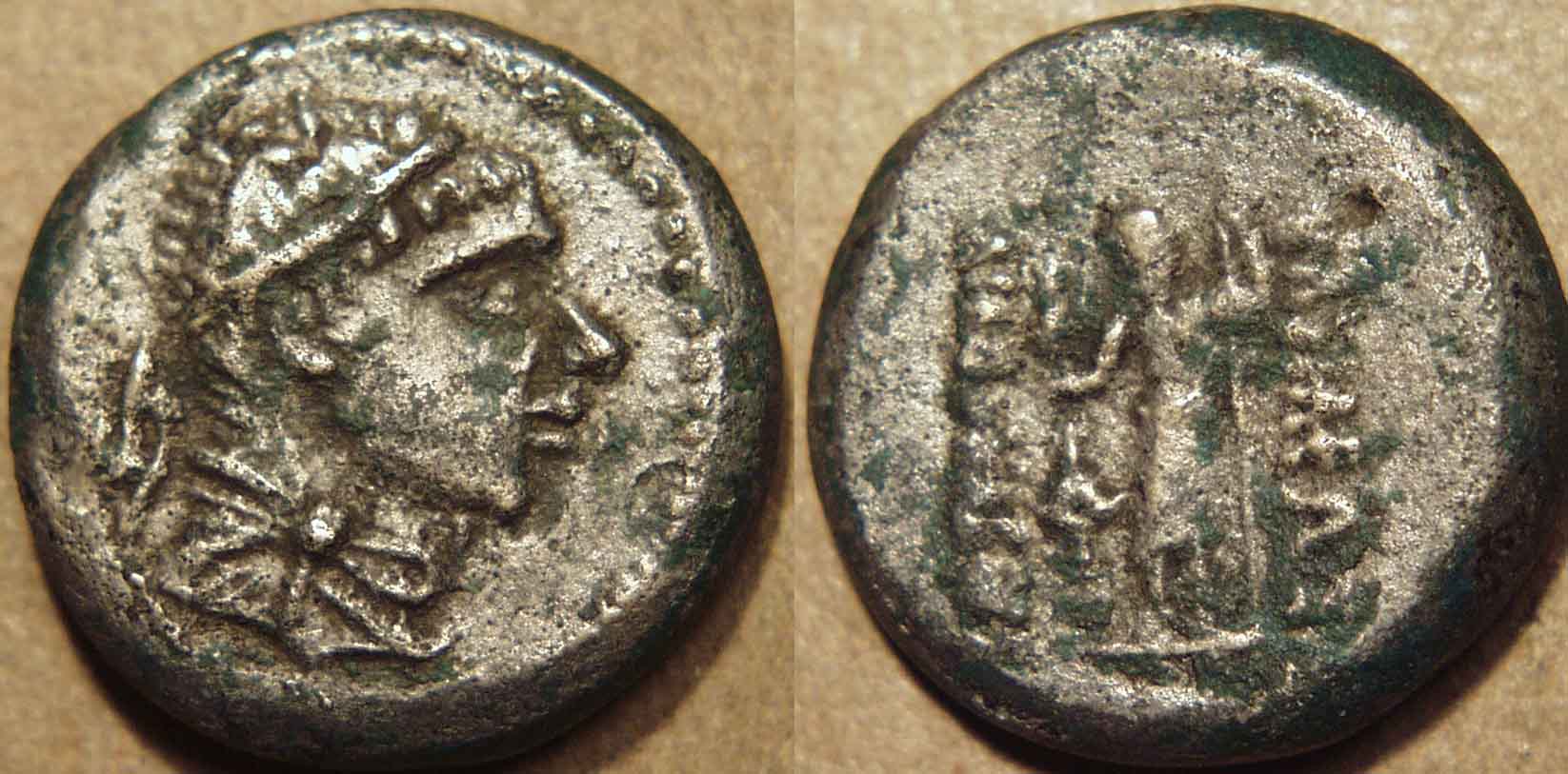
|
Bactria: Agathocles, Nickel dichalkon or double unit, c. 185-170 BCE
Weight: 8.07 gm., Diam: 20 mm., Die axis: 2 h
Diademed head of king facing right /
Zeus standing facing, holding sceptre with his left hand
and holding Hecate bearing flaming torches in his right hand,
Greek legend: BAΣIΛEΩΣ AΓAΘOKΛEOYΣ
monogram in lower left field |
 |
The crude style and inexact die axis (at 2 o'clock) on this unpublished coin type suggest that this coin was not an official issue.
It may have been an imitation of some kind.
|
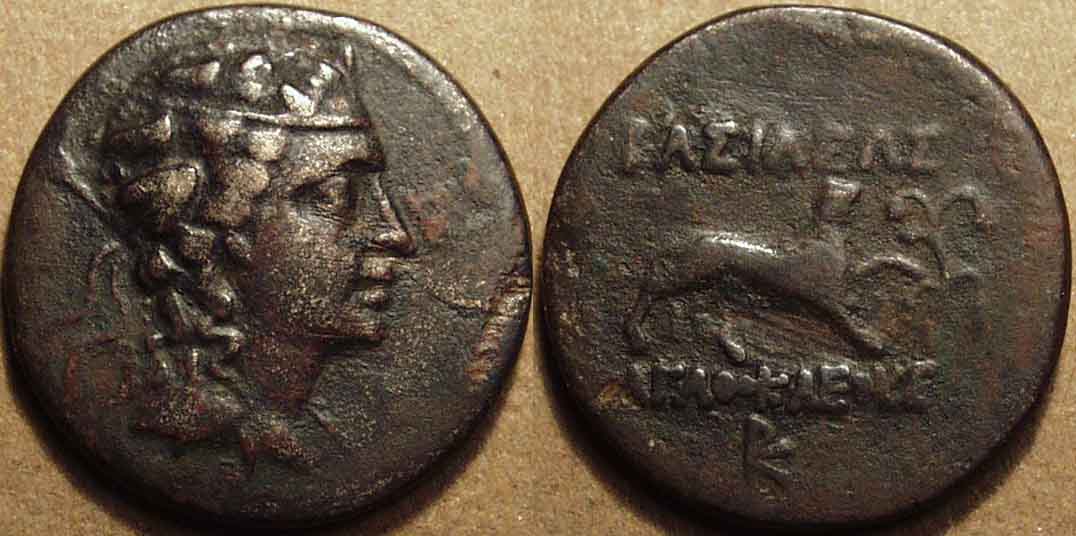
|
Bactria: Agathocles, Cupro-nickel dichalkon or double unit, c. 185-170 BCE
Weight: 7.44 gm., Diam: 23 mm., Die axis: 12 h
Laureate head of Dionysos facing right /
Panther standing right with raised paw, grape vine before
Greek legend: BAΣIΛEΩΣ AΓAΘOKΛEOYΣ
monogram in exergue |
 |
The panther was the animal associated with Dionysos and the grape vine was sacred to this god.
|
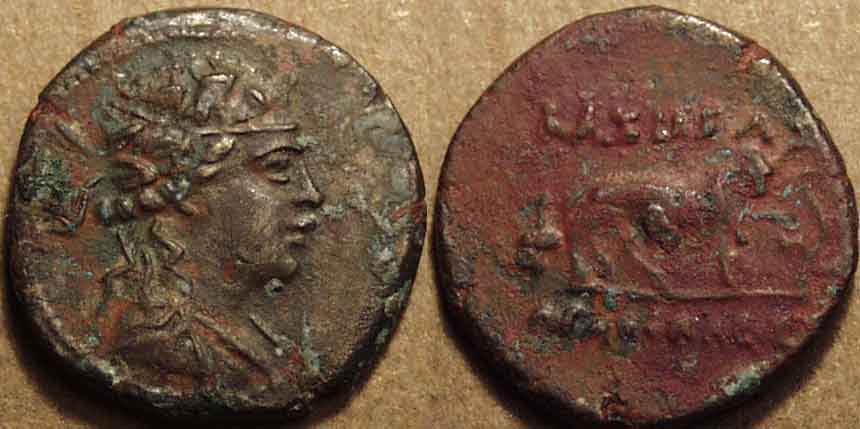
|
Bactria: Agathocles, Cupro-nickel chalkous or single unit, c. 185-170 BCE
Weight: 3.29 gm., Diam: 18 mm., Die axis: 1 h
Laureate head of Dionysos facing right /
Panther standing right with raised paw, grape vine before
Greek legend: BAΣIΛEΩΣ AΓAΘOKΛEOYΣ
monogram in exergue |
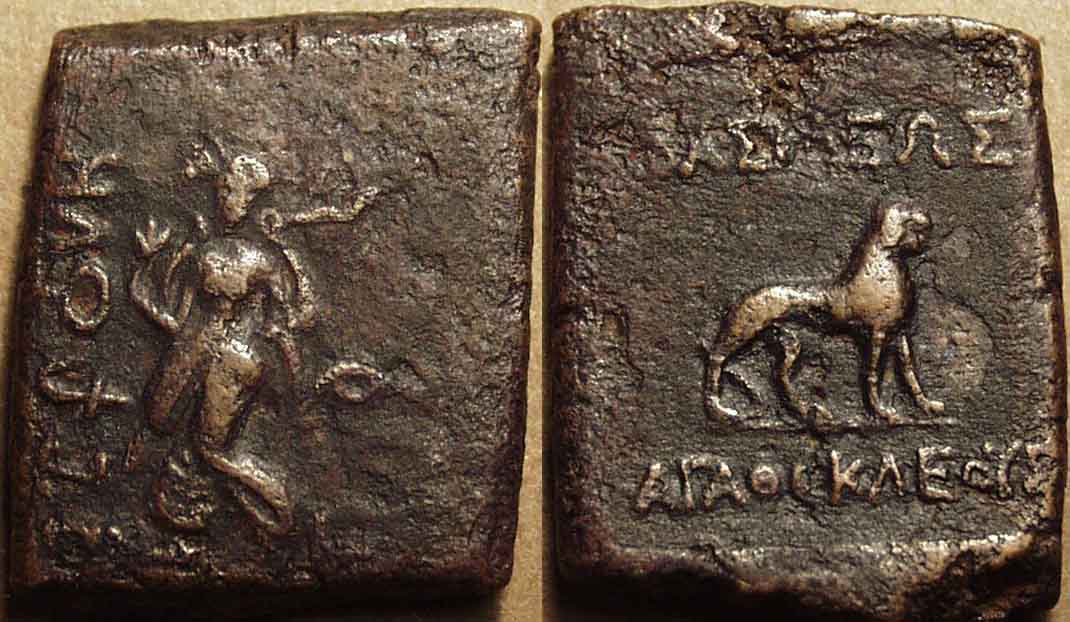
|
Bactria: Agathocles, AE double karshapana, c. 185-170 BCE
Weight: 14.45 gm., Dim: 22 x 27 mm., Die axis: 12 h
Female deity moving left, holding flower
Brahmi legend: Rajane Agathukleyasasa /
Lion standing right,
Greek legend: BAΣIΛEΩΣ AΓAΘOKΛEOYΣ |
 |
This coin parallels the similar issue of Pantaleon, and so has a claim to being the first Greek coin aimed at an Indian audience
(since we are not sure whose coins were issued earlier, Agathocles's or Pantaleon's. But we have an Indian style deity (thought by some to represent Lakshmi) holding a
lotus blossom), a square flan (recall that Mauryan coins were typically square), a legend in Brahmi, and a
weight-standard that seems to be associated with an Indian standard.
|
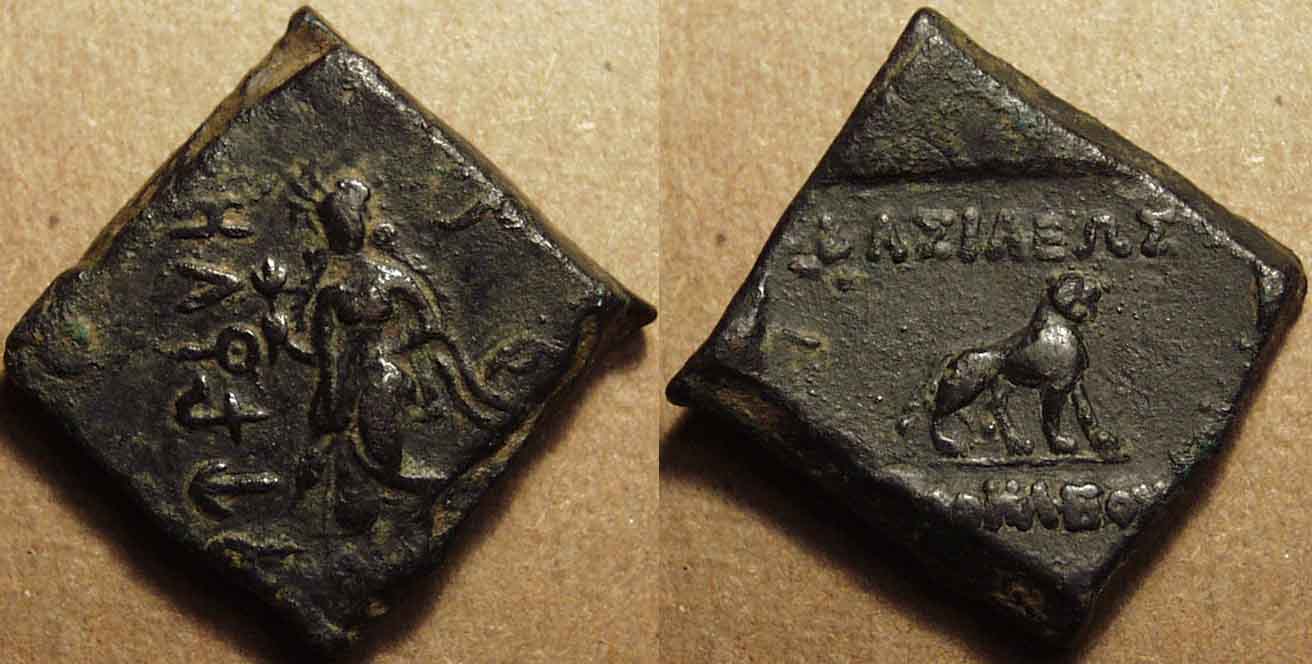
|
Bactria: Agathocles, AE one and a half karshapana, c. 185-170 BCE
Weight: 11.10 gm., Dim: 20 x 20 mm., Die axis: 12 h
Female deity moving left, holding flower
Brahmi legend: Rajane Agathukleyasasa /
Lion standing right,
Greek legend: BAΣIΛEΩΣ AΓAΘOKΛEOYΣ |

|
Bactria: Agathocles, AE dichalkon, c. 185-170 BCE
Weight: 4.90 gm., Dim: 20 x 14 mm., Die axis: 12 h
Railed tree, Kharoshthi legend below: hiranasme (golden hermitage) /
Six-arched hill, Kharoshthi legend below: akathukreyasa
Greek legend: BAΣIΛEΩΣ AΓAΘOKΛEOYΣ |
 |
Agathocles issued this enigmatic coin, thought to have been minted in Taxila. The significance of this type is still not properly
understood.
|
 |
 |
 |
The Pedigree Series |
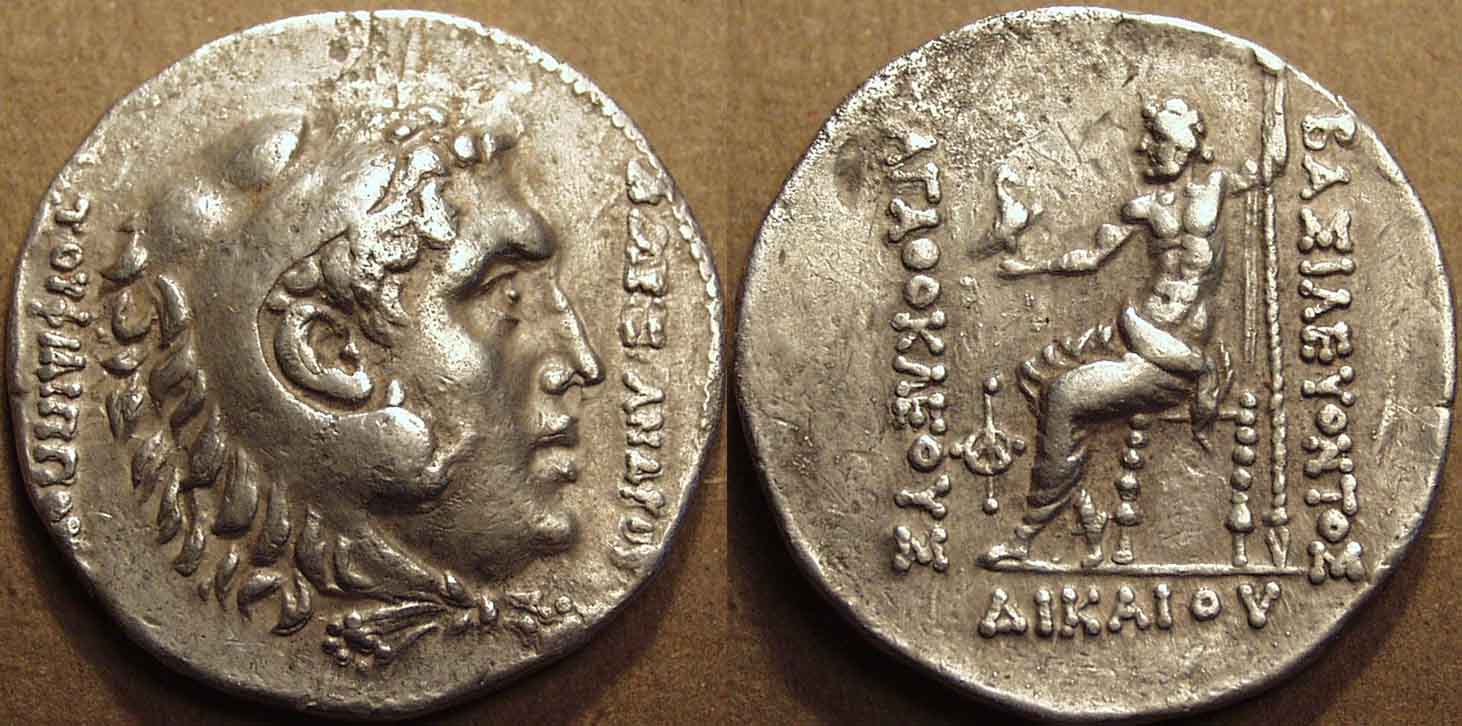
|
Bactria: Agathocles, Silver tetradrachm, c. 185-170 BCE
commemorating Alexander the Great
Weight: 16.49 gm., Diam: 31 mm., Die axis: 12 h
Head of Alexander facing right, wearing lion scalp, pearled border around
Greek legend: AΛEXANΔPOY TOY ΦIΛIΠΠOY /
Zeus enthroned left, holding sceptre behind him with his left hand
and holding eagle in his right hand,
Greek legend: BAΣIΛEYONTOΣ ΔIKAIOY AΓAΘOKΛEOYΣ
monogram in lower left field |
 |
Agathocles starts his pedigree with no less than Alexander the Great! The coin follows the obverse and reverse images of the
coins of Alexander, but adding an Alexander legend on the obverse, while preserving the Agathocles legend on the reverse.
Note the reverse legend adds the word ΔIKAIOY, the just.
This coin was incredibly important in unlocking the mystery of the pedigree coins. Until its discovery, numismatists were having a hard time figuring out what these coins
signified, and most thought they meant that Agathocles had been co-ruler with all these different kings. But once the Alexander coin was discovered, it became apparent
that these coins were intended to establish Agathocles's pedigree.
|
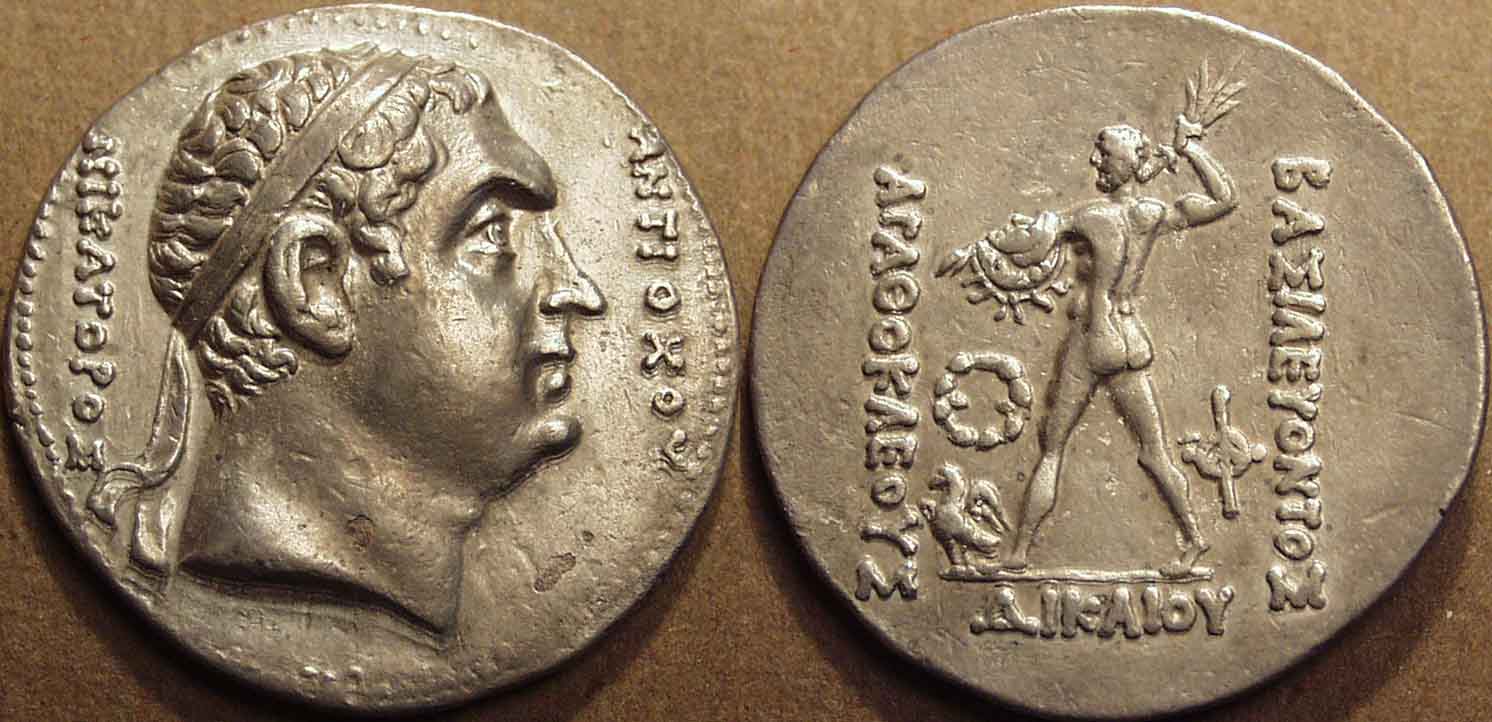
|
Bactria: Agathocles, Silver tetradrachm, c. 185-170 BCE
commemorating Diodotos I, as Satrap
Weight: 16.54 gm., Diam: 32 mm., Die axis: 12 h
Diademed head of Diodotos facing right, pearled border around
Greek legend: ANTIOXOY NIKATOPOΣ /
Nude Zeus standing left, holding aegis over his outstretched left arm
and hurling thunderbolt with his right hand,
Greek legend: BAΣIΛEYONTOΣ ΔIKAIOY AΓAΘOKΛEOYΣ
monogram in lower right field, wreath and eagle in left field |
 |
Many assumed that this coin commemorated the Seleucid emperor Antiochos I, since it bears his name, but this is clearly
incorrect. Not only does the portrait on this coin resemble that of Diodotos rather than Antiochos, but the typical Antiochos
coinage featured Apollo on the reverse, while this coin features the "thundering Zeus" of
Diodotos. In fact, the coin imitates the early coinage of Diodotos, in which the obverse featured
Diodotos's portrait, but the reverse named Antiochos, while replacing Apollo with Zeus.
|
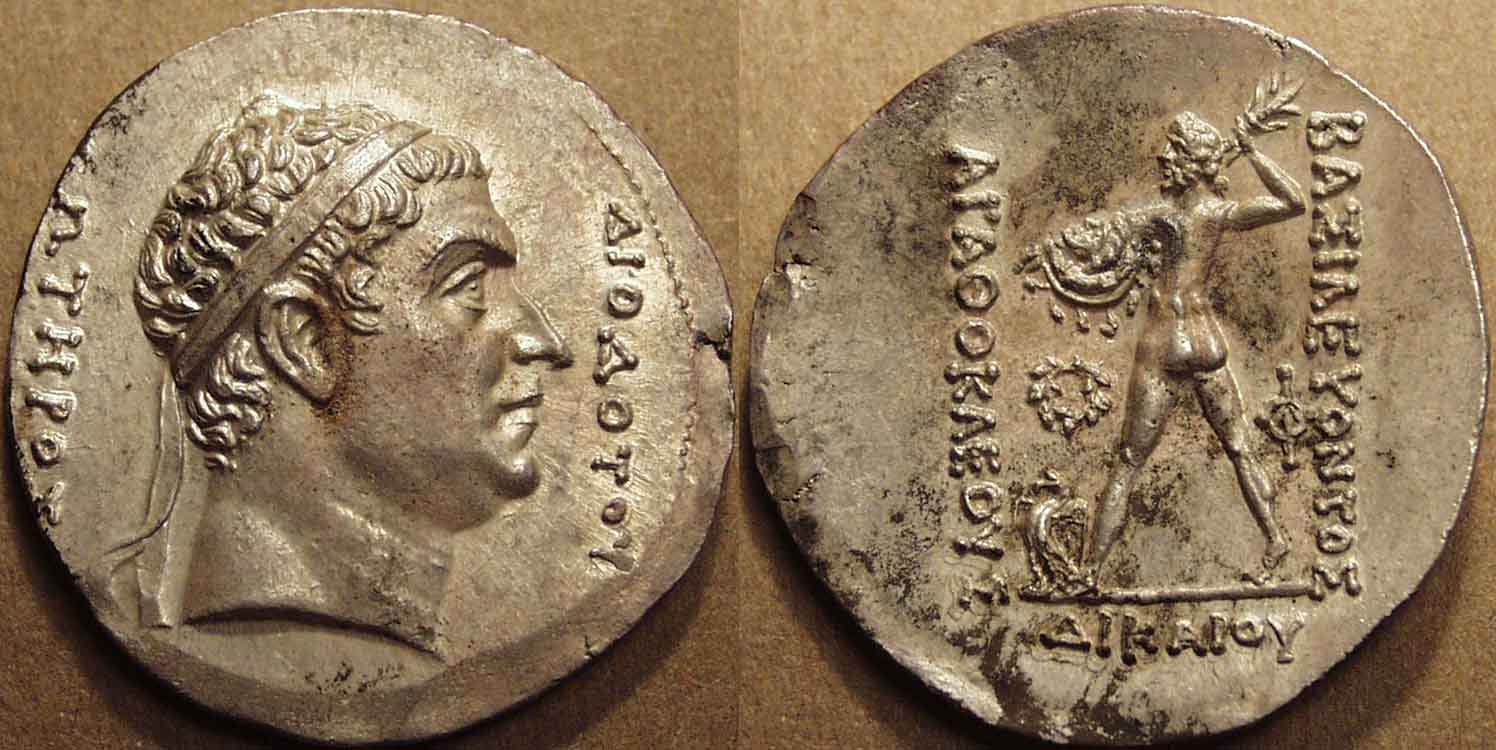
|
Bactria: Agathocles, Silver tetradrachm, c. 185-170 BCE
commemorating Diodotos I or II, as King
Weight: 16.79 gm., Diam: 32 mm., Die axis: 12 h
Diademed head of Diodotos facing right, pearled border around
Greek legend: ΔIOΔOTOY ΣΩTHPOΣ /
Nude Zeus standing left, holding aegis over his outstretched left arm
and hurling thunderbolt with his right hand,
Greek legend: BAΣIΛEYONTOΣ ΔIKAIOY AΓAΘOKΛEOYΣ
monogram in lower right field, wreath and eagle in left field |
 |
This coin commemorates King Diodotos, but it is not clear whether it is Diodotos I or II. The fact that there is another King
Diodotos commemorative, with the legend ΘEOY (god) instead of ΣΩTHPOΣ (savior) suggests that the switch from naming Antiochos to
naming Diodotos on the coinage took place during the reign of Diodotos I. Unfortunately, the epithets are not available on the original King Diodotos coinage, on which this coin is based.
|
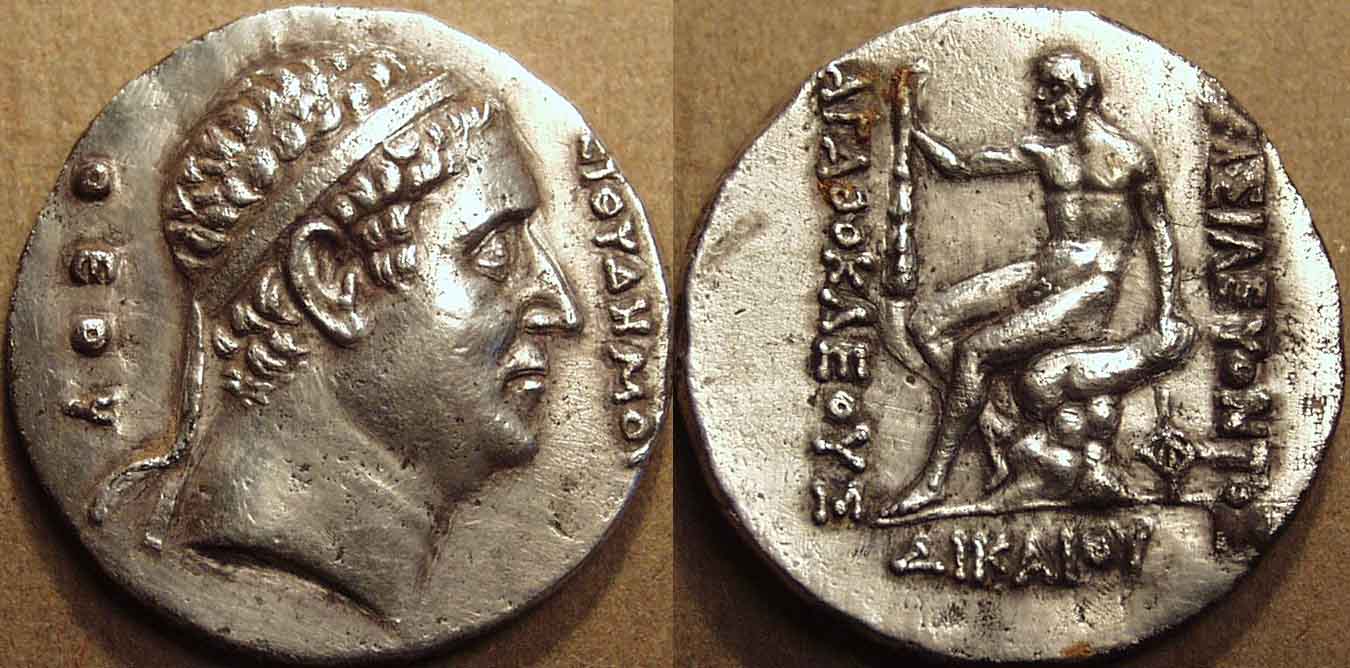
|
Bactria: Agathocles, Silver tetradrachm, c. 185-170 BCE
commemorating Euthydemos I
Weight: 15.59 gm., Diam: 29 mm., Die axis: 12 h
Diademed head of Euthydemos facing right
Greek legend: EYΘΔHMOY ΘEOY /
Nude Herakles seated left on a pile of rocks,
holding club in right hand which he rests on another pile of rocks,
Greek legend: BAΣIΛEYONTOΣ ΔIKAIOY AΓAΘOKΛEOYΣ
monogram in lower right field |
 |
This coin commemorates Euthydemos I and is based on his
standard coins with Herakles on the reverse.
|

|
Bactria: Agathocles, Silver tetradrachm, c. 185-170 BCE
commemorating Demetrios I
Weight: 16.43 gm., Diam: 35 mm., Die axis: 12 h
Diademed head of Demetrios facing right, wearing elephant-scalp head-dress,
pearled border around, Greek legend: ΔHMHTPIOY ANIKHTOY /
Nude Herakles standing facing, holding club and lion skin in left hand,
and crowning himself with his right hand,
Greek legend: BAΣIΛEYONTOΣ ΔIKAIOY AΓAΘOKΛEOYΣ
monogram in lower left field |
 |
This coin commemorates Demetrios I and faithfully records his
elephant-scalp coinage with standing Herakles reverse. Note the mint monogram on this coin differs from the one on all previous coins, suggesting that the
pedigree coins were produced at multiple mints. In fact, three mint marks are recorded for these coins and there are known specimens of several types that were
produced at two different mints.
|
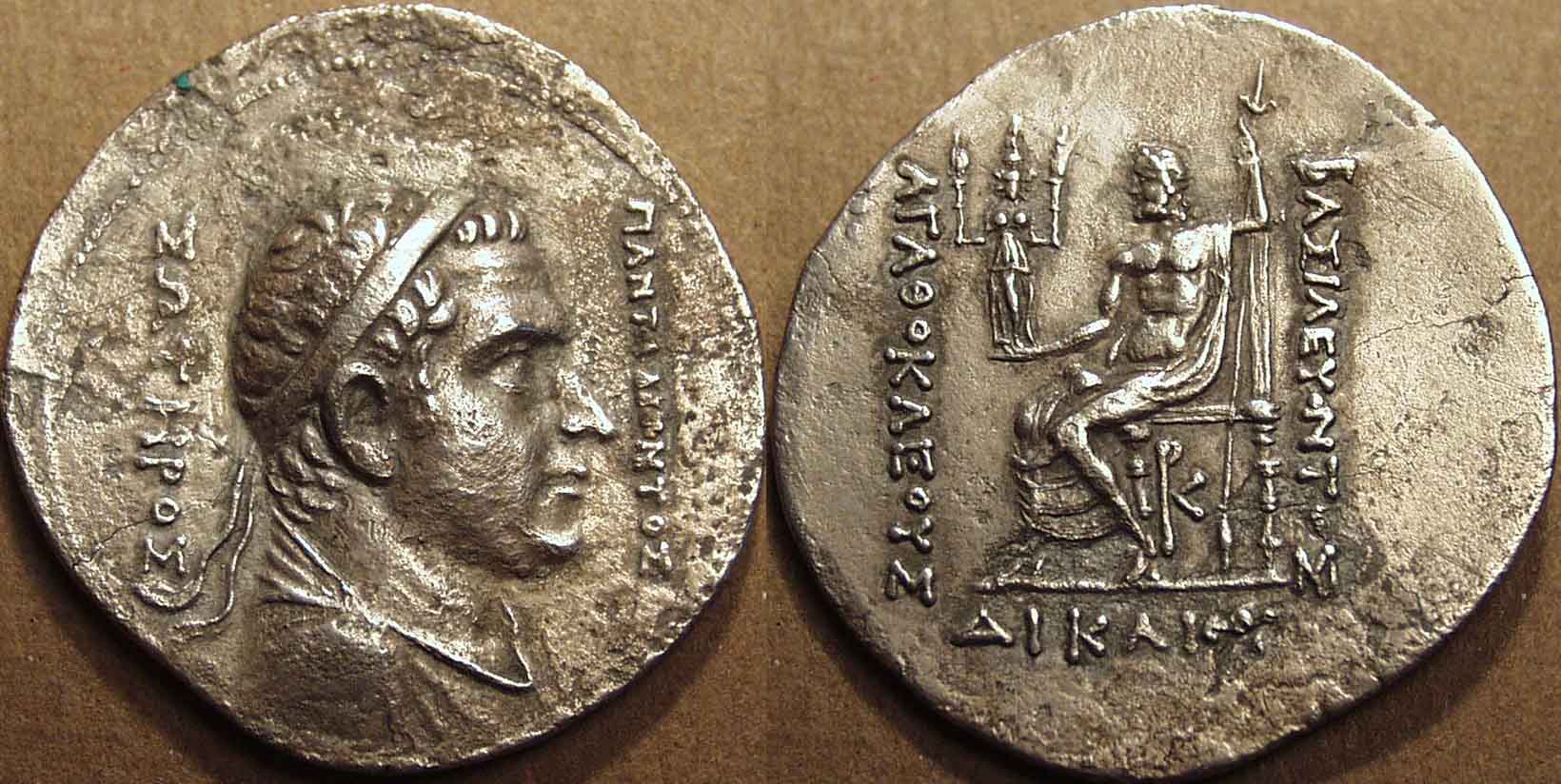
|
Bactria: Agathocles, Silver tetradrachm, c. 185-170 BCE
commemorating Pantaleon
Weight: 15.73 gm., Diam: 35 mm., Die axis: 12 h
Diademed head of Pantaleon facing right, pearled border around,
Greek legend: ΠANTAΛEONTOΣ ΣΩTHPOΣ /
Zeus enthroned left, holding sceptre behind him with his left hand
and holding Hecate bearing flaming torches in his right hand,
Greek legend: BAΣIΛEYONTOΣ ΔIKAIOY AΓAΘOKΛEOYΣ
monogram in lower left field |
 |
After Demetrios I, we would have expected a coin commemorating Euthydemos II, but so far none has been found. There are
three possibilities. First, such coins may have been minted and simply haven't been found yet. Second, for some reason Agathocles chose not to commemorate
Euthydemos II, perhaps because his reign was too insignificant, or was in a localized area not directly important to Agathocles. Third, the theory that Euthydemos II
followed Demetrios I (and hance reigned before Agathocles) is incorrect. I suspect the first is most likely, and the third the least.
Compare this coin to the tetradrachm of Pantaleon.
|
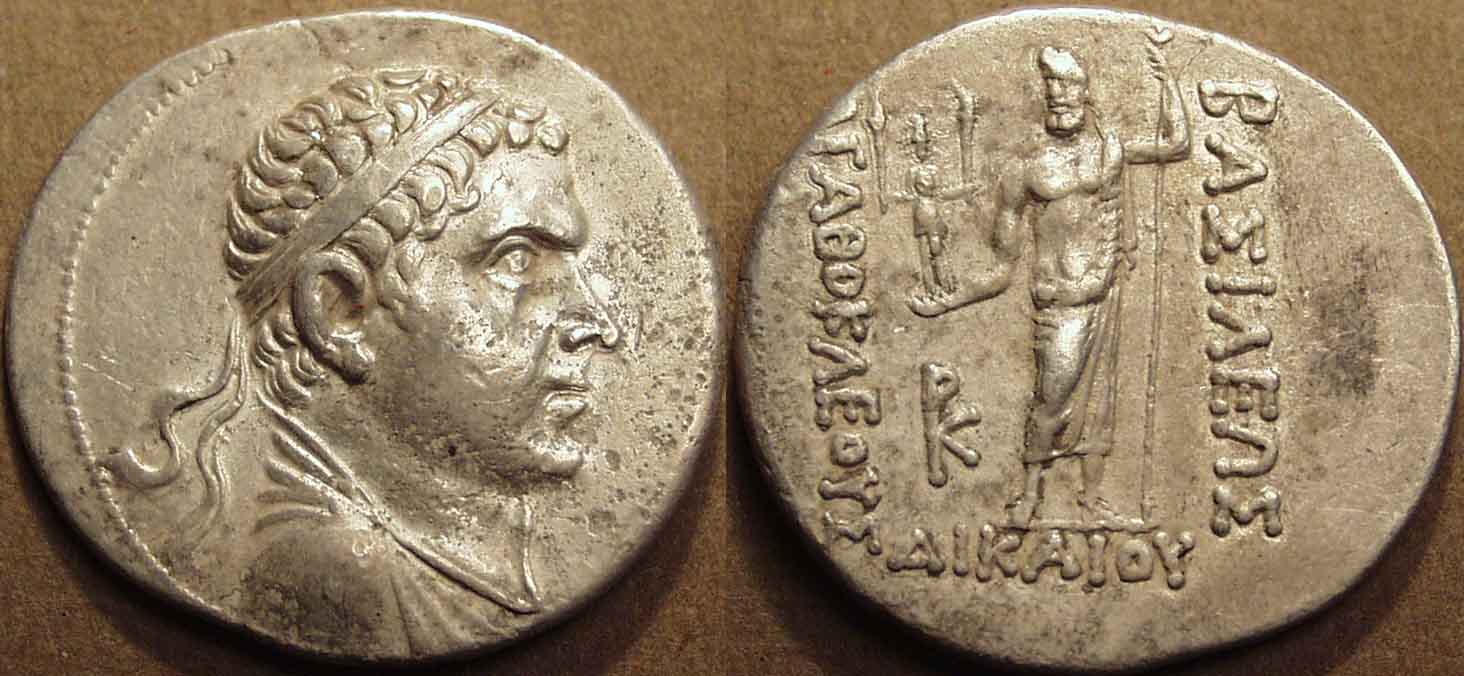
|
Bactria: Agathocles, Silver tetradrachm, c. 185-170 BCE
Weight: 16.81 gm., Diam: 29-31 mm., Die axis: 12 h
Diademed head of king facing right, pearled border around /
Zeus standing facing, holding sceptre with his left hand
and holding Hecate bearing flaming torches in his right hand,
Greek legend: BAΣIΛEΩΣ ΔIKAIOY AΓAΘOKΛEOYΣ
monogram in lower left field |
 |
Most catalogs present this coin with the earlier tetradrachm of Agathocles (first coin on this page), but I think it rightfully belongs
here, as the culmination of the Pedigree Series. It uses the reverse legend used on the entire series, which differs from the earlier coins by the addition of the word
ΔIKAIOY (just), and in this way joins itself to the pedigree coins.
Note also the slight change in the legend. Instead of using the word BAΣIΛEYONTOΣ (during the reign of King ...) seen in
the rest of the pedigree series, we have now the simple BAΣIΛEΩΣ (of King ...). My interpretation of this is that the simple
legend is fine when there is no ambiguity that this is a (coin of) King Agathocles. But when the other side of the coin shows the face and name of a different king, with a
legend in the genitive case, it is important to emphasize that the coin was issued "during the reign of King Agathocles the just (BAΣIΛEYONTOΣ ΔIKAIOY
AΓAΘOKΛEOYΣ)."
|
|
|